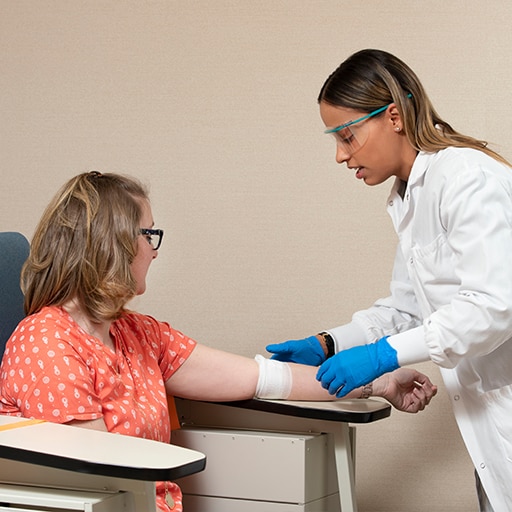An Unbiased View of Northeast Medical Institute - New Haven Campus Phlebotomy Course & Cna Class
Table of ContentsNot known Details About Northeast Medical Institute - New Haven Campus Phlebotomy Course & Cna Class The Definitive Guide to Northeast Medical Institute - New Haven Campus Phlebotomy Course & Cna ClassThe smart Trick of Northeast Medical Institute - New Haven Campus Phlebotomy Course & Cna Class That Nobody is DiscussingWhat Does Northeast Medical Institute - New Haven Campus Phlebotomy Course & Cna Class Mean?Fascination About Northeast Medical Institute - New Haven Campus Phlebotomy Course & Cna ClassThe 8-Minute Rule for Northeast Medical Institute - New Haven Campus Phlebotomy Course & Cna Class
However, using such gadgets need to be accompanied by various other infection prevention and control methods, and training in their usage. Not all safety and security gadgets apply to phlebotomy. Prior to choosing a safety-engineered device, users ought to extensively check out readily available devices to establish their proper use, compatibility with existing phlebotomy techniques, and efficacy in shielding staff and patients (12, 33).For setups with low sources, cost is a motoring consider purchase of safety-engineered tools - PCT Classes. Where safety-engineered tools are not offered, competent use of a needle and syringe is acceptable. Unintentional exposure and certain details regarding a case should be tape-recorded in a register. Support services should be advertised for those that undertake accidental direct exposure.
labelling); transport conditions; interpretation of results for clinical management. In an outpatient department or clinic, offer a specialized phlebotomy cubicle containing: a clean surface with 2 chairs (one for the phlebotomist and the various other for the patient); a hand wash basin with soap, running water and paper towels; alcohol hand rub. In the blood-sampling room for an outpatient department or center, supply a comfortable reclining couch with an arm remainder.
The smart Trick of Northeast Medical Institute - New Haven Campus Phlebotomy Course & Cna Class That Nobody is Talking About
Ensure that the indicators for blood sampling are plainly specified, either in a written protocol or in documented guidelines (e.g. in a lab form). Accumulate all the tools needed for the procedure and place it within risk-free and very easy reach on a tray or trolley, making certain that all the things are clearly noticeable.
Where the person is grown-up and aware, comply with the actions laid out listed below. Present yourself to the individual, and ask the person to state their complete name. Inspect that the lab type matches the individual's identification (i.e. match the person's information with the research laboratory type, to make sure precise recognition). Ask whether the license has allergies, anxieties or has actually ever before passed out throughout previous injections or blood draws.
Make the individual comfortable in a supine position (preferably). Location a tidy paper or towel under the client's arm. Go over the examination to be executed (see Annex F) and obtain verbal permission. The person has a right to refuse a test any time prior to the blood tasting, so it is very important to ensure that the individual has understood the procedure.
Little Known Questions About Northeast Medical Institute - New Haven Campus Phlebotomy Course & Cna Class.
Expand the individual's arm and a fantastic read inspect the antecubital fossa or lower arm. Find a blood vessel of a good size that is visible, straight and clear.
DO NOT place the needle where veins are drawing away, due to the fact that this increases the possibility of a haematoma. Finding the blood vessel will certainly help in figuring out the appropriate dimension of needle.
Haemolysis, contamination and existence of intravenous liquid and medication can all alter the results (39. Nursing staff and doctors might access central venous lines for specimens following protocols. Samplings from main lines carry a risk of contamination or wrong research laboratory examination outcomes. It is acceptable, but not optimal, to draw blood specimens when very first introducing an in-dwelling venous gadget, before linking the cannula to the intravenous fluids.
Facts About Northeast Medical Institute - New Haven Campus Phlebotomy Course & Cna Class Uncovered
Enable the location to completely dry. Failure to permit adequate call time raises the risk of contamination. DO NOT touch the cleaned up site; specifically, DO NOT position a finger over the vein to assist the shaft of the revealed needle. It the website is touched, repeat the sanitation. Do venepuncture as adheres to.
Ask the client to form a hand so the capillaries are much more noticeable. Go into the vein swiftly at a 30 degree angle or much less, and remain to introduce the needle along the blood vessel at the most convenient angle of entry - Phlebotomy Courses. When sufficient blood has been accumulated, release the tourniquet prior to withdrawing the needle
All About Northeast Medical Institute - New Haven Campus Phlebotomy Course & Cna Class
Withdraw the needle carefully and use gentle stress to the website with a clean gauze or completely dry cotton-wool sphere. Ask the client to hold the gauze or cotton wool in position, with the arm expanded and elevated. Ask the client NOT to flex the arm, because doing so causes a haematoma.
:max_bytes(150000):strip_icc()/Primary_Image-b2e24c37575f48279cff673865d3853c.jpg)
Some Ideas on Northeast Medical Institute - New Haven Campus Phlebotomy Course & Cna Class You Need To Know
Do not push the syringe bettor due to the fact that additional stress enhances the danger of haemolysis. Where possible, maintain the tubes in a rack and relocate the shelf in the direction of you. Infuse downwards right into the ideal coloured stopper. DO NOT remove the stopper since it will launch the vacuum cleaner. If the sample tube does not have a rubber stopper, inject extremely gradually right into television as lessening the stress and speed utilized to move the specimen decreases the danger of haemolysis.
